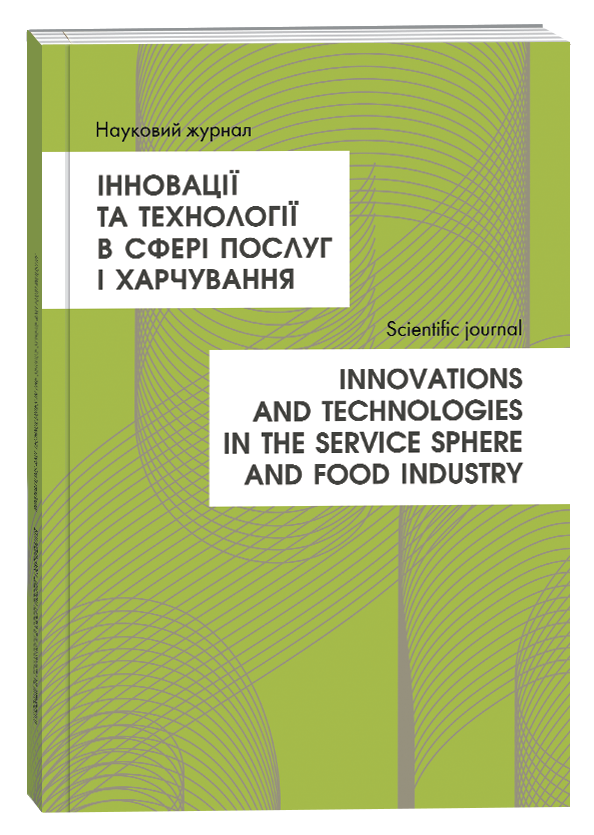ДОСЛІДЖЕННЯ ПРОЦЕСУ ТА РОЗРОБКА ТЕХНОЛОГІЇ ВИРОБНИЦТВА КРЕМ-МЕДУ
Abstract
Honey is one of the most popular foods. Due to its high biological value, its role in nutrition goes beyond simply being a natural sweetener. However, the classic consistency of honey is not always convenient for consumption due to crystallization, which makes it difficult to use in food. Honey with soft, fine-grained crystallization, similar to cream, is in much greater demand. It has a delicate texture and is easy to spread, which makes it popular among household consumers, restaurants, and confectionery manufacturers. The standard technology for producing cream-honey is a long-term, and therefore quite energy-intensive, process. Therefore, the development of a technology for the production of cream honey using an accelerated method is an urgent and timely task. Acacia, linden, sunflower, and paddy honey, which were sold in retail stores in the city of Dnipro in 2024, were used as samples. It was found that acacia honey had the best performance in terms of organoleptic and microscopic indicators, diastase activity, water content, presence of sugar and starch molasses, flour, starch, and gelatin. Linden and paddy honey met the requirements of DSTU 4497:2005. Sunflower honey showed signs of falsification. It was found that increasing the duration of the acacia honey churning process from 5 to 25 min at a constant frequency (421 rpm) leads to a decrease in density and an increase in the specific volume of the finished product, which indicates intensive saturation of honey with air. Further increase in the duration of whipping has no effect on the studied parameters. With a duration of the whipping process of 15 minutes or more, a significant decrease in the size and number of honey crystals is observed, and with a duration of 25 minutes, they are completely absent. It was found that changing the whipping frequency for the same process duration also has a significant impact on the final product. The greatest saturation of honey with air can be achieved at the maximum speed of the working body of the beater (three speeds were studied: 132 / 235 / 421 rpm). Reducing the intensity of whipping reduces the degree of air saturation of the finished product. In addition, during the studied duration, reducing the frequency of whipping does not allow the honey crystals to be completely dissolved. This technology can be used to develop functional cream-honey.
References
Md Lokman Hossain, Lee Yong Lim, Katherine Hammer, Dhanushka Hettiarachchi, Cornelia Locher. Honey-Based Medicinal Formulations: A Critical Review. Applied Sciences. 2021. Vol. 11, Is. 11. P. 51-59. DOI: https://doi.org/10.3390/app11115159
Melanie Howard. How To Make Creamed Honey – The Dyce Method. Beekeeping for Newbies. 2021. URL: https://www.beekeepingfornewbies.com/how-to-make-creamed-honey-the-dyce-method/ (дата звернення: 26.03.2025).
Mohamed G. Sharaf El-Din, Abdelaziz F.S. Farrag, Liming Wu, Yuan Huang, Kai Wang. Health benefits of honey: A critical review on the homology of medicine and food in traditional and modern contexts. Journal of Traditional Chinese Medical Sciences. 2025. DOI: https://doi.org/10.1016/j.jtcms.2025.03.015
Priscila Missio da Silva, Cony Gauche, Luciano Valdemiro Gonzaga, Ana Carolina Oliveira Costa, Roseane Fett. Honey: Chemical composition, stability and authenticity. Food Chemistry. 2016. Vol. 196, P. 309-323. DOI: https://doi.org/10.1016/j.foodchem.2015.09.051
Reshma Krishnan, Thasniya Mohammed, Gopika S Kumar, Arunima S H. Honey crystallization: Mechanism, evaluation and application. The Pharma Innovation. 2021. Vol. 10, Special Issue 5. Р. 222-231. DOI: https://doi.org/10.22271/tpi.2021.v10.i5Sd.6213
Santos-Buelga C., Gonzalez-Paramas A.M. Chemical Composition of Honey. Bee Products ‒ Chemical and Biological Properties. Switzerland: Springer Cham, 2017. P. 43-82. DOI: https://doi.org/10.1007/978-3-319-59689-1_3
Schell Kathleen R., Fernandes Kenya E., Shanahan Erin, Wilson Isabella, Blair Shona E., Carter Dee A., Cokcetin Nural N. The potential of honey as a prebiotic food to re-engineer the gut microbiome toward a healthy state. 2022. Vol. 9. DOI: https://doi.org/10.3389/fnut.2022.957932.
Коцюмбас О. Кремування меду. Бджоляр. 2012. № 1. С. 14-16.
Лисенко Г. Л., Прудніков В. Г., Леппа А. Л., Гейда І. М., Бучковська К. Д. Виробництво кремованого меду з меду натурального різного ботанічного походження. Ветеринарія, технології тваринництва та природокористування. 2019. № 3. С. 22-28. DOI: https://doi.org/10.31890/vttp.2019.03.04
Мед натуральний. Технічні умови: ДСТУ 4497:2005. Чинний від 2007-01-01. Київ : Держспоживстандарт України, 2007. 22 с.
Hossain M. L., Lim L. Y., Hammer K., Hettiarachchi D., Locher C. (2021) Honey-Based Medicinal Formulations : A Critical Review. Applied Sciences, vol. 11(11). рр. 51-59. DOI: http://dx.doi.org/10.3390/app11115159
Melanie Howard. How To Make Creamed Honey – The Dyce Method. Beekeeping for Newbies. 2021. Available at: https://www.beekeepingfornewbies.com/how-to-make-creamed-honey-the-dyce-method/ (accessed March 26, 2025).
Mohamed G. Sharaf El-Din, Abdelaziz F.S. Farrag, Liming Wu, Yuan Huang, Kai Wang (2025) Health benefits of honey: A critical review on the homology of medicine and food in traditional and modern contexts. Journal of Traditional Chinese Medical Sciences. DOI: http://dx.doi.org/10.1016/j.jtcms.2025.03.015
Priscila Missio da Silva, Cony Gauche, Luciano Valdemiro Gonzaga, Ana Carolina Oliveira Costa, Roseane Fett (2016) Honey: Chemical composition, stability and authenticity. Food Chemistry, vol. 196, рр. 309-323. DOI: https://doi.org/10.1016/j.foodchem.2015.09.051
Reshma Krishnan, Thasniya Mohammed, Gopika S Kumar, Arunima S H. (2021) Honey crystallization: Mechanism, evaluation and application. The Pharma Innovation, vol. 10(5S), рр. 222-231. DOI: http://dx.doi.org/10.22271/tpi.2021.v10.i5Sd.6213
Santos-Buelga C., Gonzalez-Paramas A. M. (2017) Chemical Composition of Honey. Bee Products ‒ Chemical and Biological Properties. Switzerland: Springer Cham, рр. 43-82. DOI: http://dx.doi.org/10.1007/978-3-319-59689-1_3
Schell Kathleen R., Fernandes Kenya E., Shanahan Erin, Wilson Isabella, Blair Shona E., Carter Dee A., Cokcetin Nural N. (2022) The Potential of Honey as a Prebiotic Food to Re-engineer the Gut Microbiome Toward a Healthy State. Frontiers in Nutrition, vol. 9. DOI: http://dx.doi.org/10.3389/fnut.2022.957932
Kotsiumbas O. (2012) Kremuvannia medu [Honey cremation]. Bdzholiar, № 1, рр. 14-16ю (in Ukrainian)
Lysenko H., Prudnikov V., Leppa A., Heyda I., Buchkovska K. (2019) Vyrobnytstvo kremovanoho medu z medu naturalnoho riznoho botanichnoho pokhodzhennia [The production cremated honey from naturalhoneyof different botanical origin]. Veterinary science,technologies of animal husbandry and nature management, № 3, рр. 22-28. DOI: https://doi.org/10.31890/vttp.2019.03.04
DSTU 4497:2005. Med naturalnyi. Tekhnichni umovy. [Chynnyi vid 2007-01-01]. Vyd. ofits. (2007) Kyiv: Derzhspozhyvstandart Ukrainy, 22 p.



